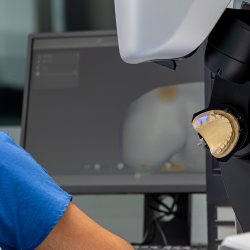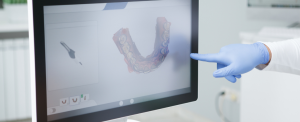CAD/CAM design is a technology that allows the creation of personalized dental restorations through a process of computer-aided design (CAD) and computer-assisted manufacturing (CAM).
This technology can make a difference in the quality of treatment and patient satisfaction, while optimizing internal processes. What are its advantages? Let’s get ready to enter the future of dentistry.
Greater precision: CAD/CAM restorations are manufactured with millimeter precision, which guarantees a perfect fit. This helps prevent problems such as tooth sensitivity and secondary cavities.
Shorter working time: Also, as we have mentioned in other articles, it reduces the dentist’s working hours, which allows the professional to care for more patients in less time.
Better aesthetics: CAD/CAM restorations can replicate the color and shape of natural teeth (characterization), which improves the quality of the final result considerably.
Design options
There is a very complete variety of CAD/CAM options available for dentists. Among the most common are:
Crowns and bridges: They help replace one or more teeth. Regardless of the tooth that is included in said analysis or that the patient requires.
Inlays and onlays: CAD/CAM inlays and onlays are partial restorations that are placed on the inner or outer part of a tooth. Being a very popular option due to its durability and ability to restore the appearance and function of the damaged tooth without having the need to remove a large amount of healthy dental tissue. All this, of course, depends on the specific situation.
Veneers: CAD/CAM veneers are thin sheets that are placed on the front surface of the teeth to improve their appearance. Also very on the rise due to the speed of its manufacture with the intraoral scanner.
Advantages for patients

More lasting restorations:
1- High quality: With CAD/CAM technology, it is possible to use high-quality materials and state-of-the-art ceramics that are very resistant to wear and fractures. These materials tend to last longer compared to those used in traditional restorations.
2- Reduction of human errors: In old (analogous) procedures, the taking of prints and the manufacture of restorations depend largely on the skill and precision of the dental technician or the dentist. CAD/CAM technology reduces this human lack in design and manufacturing.
Fewer visits: Reduces the number of visits to the dentist necessary to complete a treatment.
Less pain: This is clearly due to the design and the effectiveness it has from the first moment of doing the CAD/CAM procedure. This translates into less pain and the discomfort associated with subsequent adjustments.
Do you need advice or a trusted partner to carry out your work? At SOi we are experts in the digital workflow, with services designed for dentists, clinics and dental laboratories, to whom we deliver first-class digital design and manufacturing services, with 24/7 support and dispatch times in a matter of hours.
You can start quickly by applying for your jobs or sending us your oral acquisitions here.



